Can Urban Street Network Characteristics Indicate Economic Development Level? Evidence from Chinese Cities
Abstract
1. Introduction
2. Related Literature
2.1. Characterizing Street Networks Using Complex Network Approaches
2.2. Understanding the Relationship between Street Networks and Economic Development from a Network Perspective
3. Methodology
3.1. The Proposed Analytical Framework
3.2. Characterizing Street Network Structures
3.3. Hierarchical Clustering Analysis
- Step 1: Have each city start in its own cluster; calculate the Euclidean distance between each pair of cities in the feature space.
- Step 2: Merge the pairs of clusters into a new cluster based on the minimum distance between pairs.
- Step 3: Calculate the distance between the new cluster and others again.
- Step 4: Repeat Steps 2 and 3 until all cities merge into one cluster.
4. Case Study
4.1. Study Area and Data Source
4.2. The Characteristics of Street Networks
4.2.1. Betweenness Centrality of Street Networks
- Rectangular grid: Eight cities including Beijing and Chengdu fall into this type. The typical characteristics of these cities are that the distribution curve is gentle and the slope value is more than 0.95, the street network is a rectangular grid, the density of road nodes is high, and the average street length is relatively long.
- Multiple group rectangular grid: Seven cities including Nanjing, Chongqing, and Wuhan are in this group. The common characteristics of these cities are that the range of slope value is equal to or less than 0.95 while more than 0.9, the spatial distribution of the street networks presents multiple rectangular grid groups, and the density of street intersections is high.
- Circle shape grid: Shenyang and six other cities are classified into this group. The typical characteristics of these cities are that the range of slope value is equal to or less than 0.9 while more than 0.85, the morphological structure of the city presents a circle shape grid, and the average street length is short.
- Strips grid: Cities including Xining, Yinchuan, and Lanzhou are classified into this type. The common characteristics of cities of this type are that the range of slope values is equal to or less than 0.85, the form of street network presents a strip shape, and the average street length is relatively long compared with cities classified in the other types.
4.2.2. Closeness Centrality of Street Networks
4.3. Relationship between a Street Network and Economic Development
- The first cluster includes three cities: Lhasa, Lanzhou, and Urumchi. All cities in this cluster are located in western China and belong to the western economic region. In general, cities in the western economic region have lower economic development levels than cities in the other three regions. However, the region is a major energy industry development area in China and has formed a good economic growth pole. In this cluster, the street networks of cities are either strip-shaped or have multiple discrete heterogeneous centers. Moreover, the density of street nodes is generally low, and the length of the average street segment is relatively long in all three cities.
- The second cluster includes five cities from Hohhot to Yichuan. Cities in this cluster also belong to the western economic region. In this cluster, the street networks of Guiyang and Hohhot present the shape of a multiple group rectangular grid, while the street networks of the rest of the cities are strip-shaped.
- The third cluster includes five cities from Taiyuan to Shenyang. Three of the five cities, other than Shenyang and Harbin, belong to the central economic region. Among the four regions, cities in the central economic region have the fastest economic growth rate. In this cluster, the street networks of most cities either have a shape with multiple group rectangular grids or have multiple discrete heterogeneous centers. Additionally, the density of nodes is high, and the length of the average street segment is long in these cities.
- The fourth cluster consists of nine cities, including Beijing and Wuhan. Most of these cities are located in eastern China and belong to the eastern economic region, where economic development is more advanced than cities in other parts of China. The street networks of these cities either present the shape of a rectangular grid or have multiple discrete heterogeneous centers.
- The fifth cluster consists of seven cities, including Hefei and Ji’nan. Among them, three cities belong to the eastern economic region, two cities belong to the central economic region, and the other two belong to the western and northeastern economic regions, respectively. Although cities in this cluster belong to different economic regions, the street network of most cities in this cluster either present the shape of a multiple group rectangular grid or have a multi-centered network structure with a continuous homogeneous distribution.
5. Discussion and Conclusions
Author Contributions
Funding
Acknowledgments
Conflicts of Interest
Appendix A

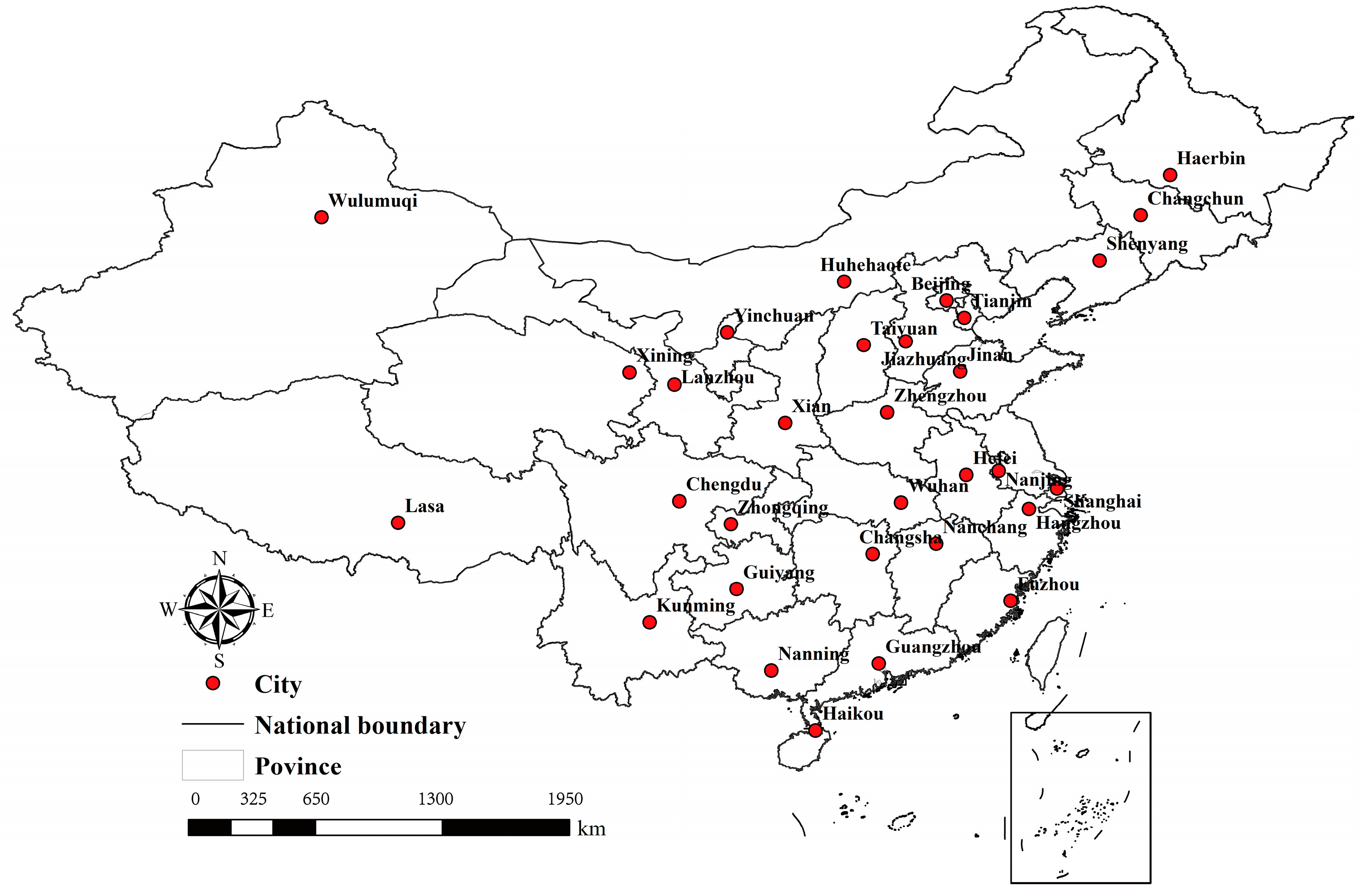

| City | Nodes <N> | Edge <L> | Avg_length (m) | Inter_Density (km2) |
|---|---|---|---|---|
| Beijing | 54,264 | 130,192 | 336.05 | 33.10 |
| Guangzhou | 41,322 | 90,250 | 279.71 | 28.47 |
| Shanghai | 39,392 | 96,957 | 346.47 | 33.95 |
| Tianjin | 37,503 | 89,817 | 394.86 | 31.12 |
| Chengdu | 27,106 | 67,326 | 310.44 | 28.18 |
| Chongqing | 25,123 | 56,480 | 629.55 | 15.26 |
| Hangzhou | 23,397 | 56,169 | 375.14 | 35.67 |
| Wuhan | 23,251 | 53,693 | 378.54 | 33.33 |
| Xi’an | 21,330 | 54,695 | 361.38 | 33.54 |
| Nanjing | 18,683 | 46,329 | 420.62 | 20.99 |
| Shijiazhuang | 13,774 | 37,988 | 308.69 | 41.42 |
| Changchun | 12,105 | 29,327 | 387.33 | 20.22 |
| Ji’nan | 9857 | 23,026 | 445.72 | 19.21 |
| Changsha | 9488 | 21,079 | 330.81 | 25.24 |
| Shenyang | 8985 | 22,102 | 504.09 | 13.66 |
| Kunming | 8981 | 20,213 | 413.30 | 17.47 |
| Hefei | 8839 | 19,371 | 296.09 | 17.69 |
| Nanchang | 8217 | 18,182 | 365.87 | 23.05 |
| Zhengzhou | 7916 | 18,349 | 347.38 | 16.52 |
| Harbin | 7125 | 17,847 | 519.00 | 14.47 |
| Fuzhou | 5579 | 12,120 | 375.03 | 16.85 |
| Taiyuan | 5452 | 11,273 | 369.07 | 14.59 |
| Guiyang | 5018 | 9942 | 541.35 | 14.45 |
| Hohhot | 4676 | 10953 | 364.45 | 14.59 |
| Nanning | 4407 | 9586 | 674.46 | 12.12 |
| Haikou | 2842 | 5778 | 294.50 | 18.10 |
| Lhasa | 2289 | 5288 | 440.47 | 18.87 |
| Xining | 1639 | 3523 | 439.41 | 17.34 |
| Urumchi | 1525 | 3875 | 1005.19 | 2.93 |
| Lanzhou | 979 | 2280 | 1017.41 | 2.36 |
| Yinchuan | 763 | 1926 | 571.26 | 3.72 |
| Type | City | Slope | Characteristic |
|---|---|---|---|
| A | Beijing, Chengdu, Shijiazhuang, Guangzhou, Hangzhou, Shanghai, Tianjin, Xi’an | >0.95 | Traffic network form presents a rectangular grid, high density of road node, and longer street average |
| B | Nanjing, Chongqing, Wuhan, Changsha, Changchun, Fuzhou, Haikou, Jinan, Kunming, Hefei | (0.9, 0.95) | Traffic network form presents multiple group rectangular grid, high density of road node, and longer street average |
| C | Shenyang, Guiyang, Harbin, Hohhot, Nanchang, Zhengzhou | (0.85, 0.9) | Traffic network form presents multiple group rectangular grid, high density of road node, and longer street average |
| D | Xining, Yinchuan, Urumqi, Lanzhou, Lhasa, Nanning, Taiyuan | <=0.85 | Traffic network form presents strips, low density of road node, and longer street average |
| Type | City | Slope | Characteristic |
|---|---|---|---|
| A | Xi’an, Shijiazhuang, Jinan, Tianjin, Guangzhou, Shanghai, Haikou, Fuzhou, Zhengzhou, Kunming, Xining | >=1 | Multi-center network structure, continuous homogeneous distribution |
| B | Chongqing, Yinchuan, Chengdu, Nanjing, Hefei, Changsha, Hohhot, Nanchang, Nanning, Urumqi, Hangzhou, Lhasa, Guiyang, Shenyang, Changchun, Beijing, Harbin, Lanzhou, Taiyuan, Wuhan | <1 | Multi-center network structure, discrete heterogeneous distribution |
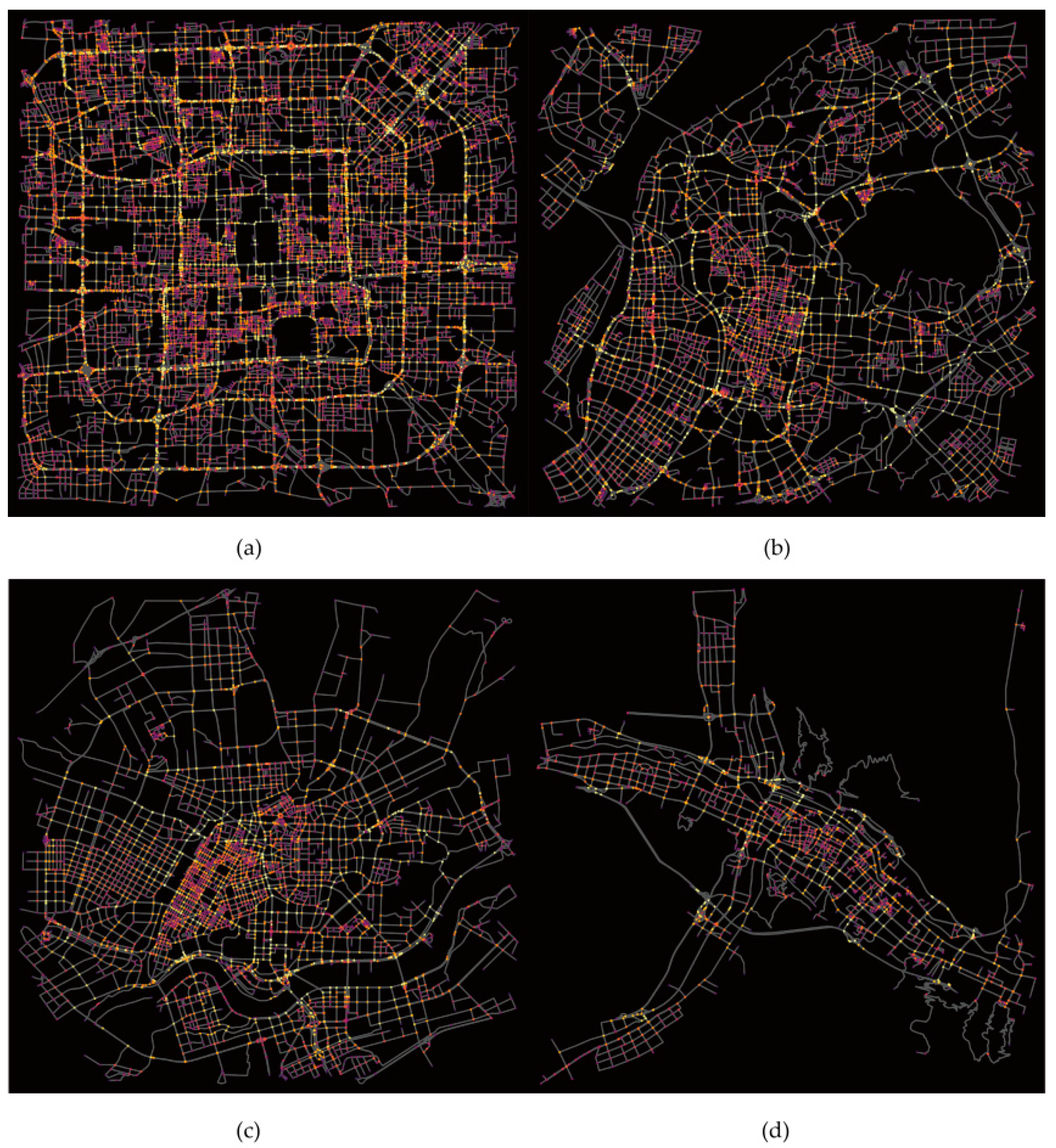
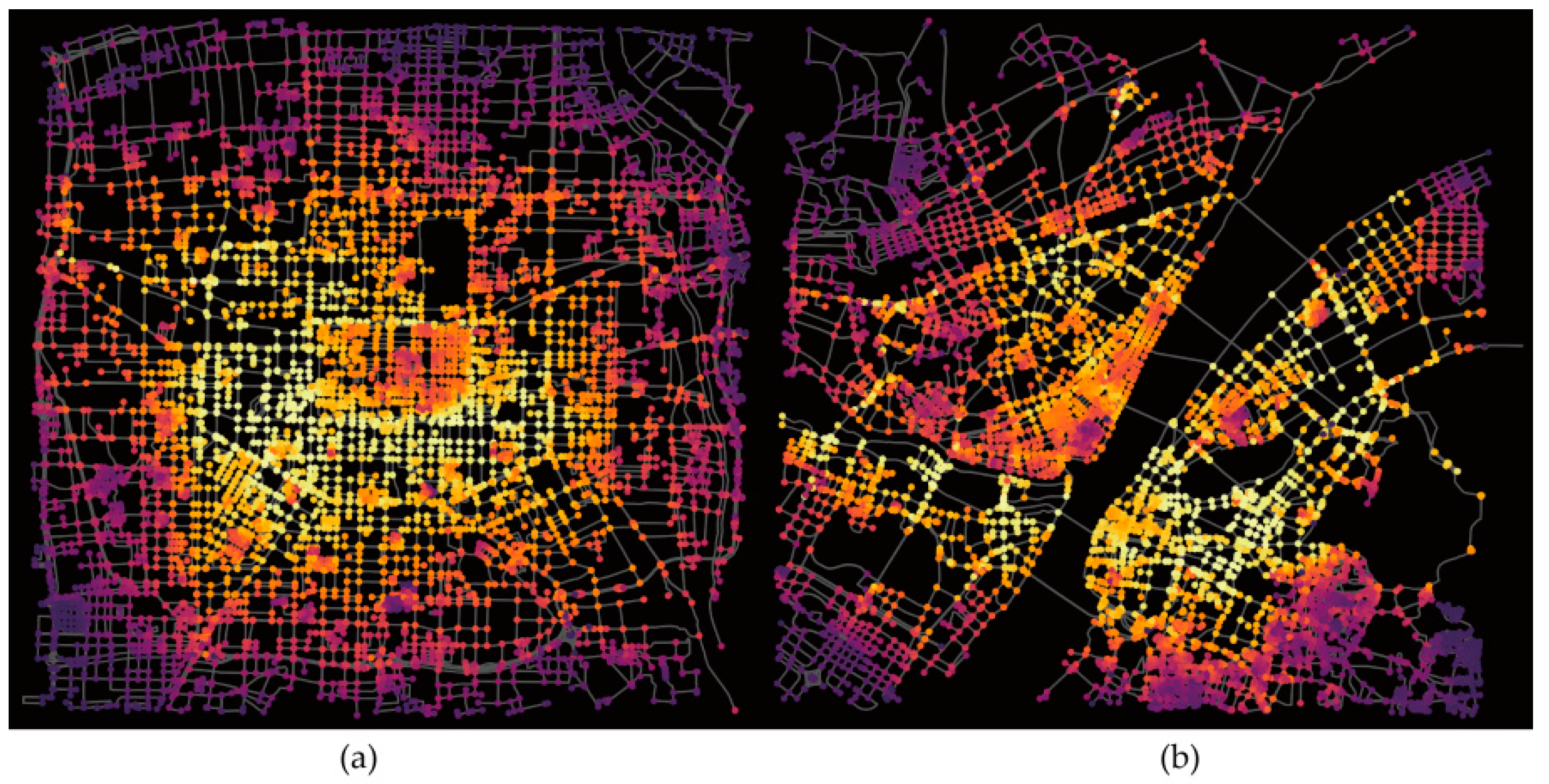
References
- Tian, Z.; Jia, L.; Dong, H.; Su, F.; Zhang, Z. Analysis of Urban Road Traffic Network Based on Complex Network. Procedia Eng. 2016, 137, 537–546. [Google Scholar] [CrossRef]
- Jin, F.; Wang, C.; Cao, Y.; Cao, X.; Wang, J.; Dai, T.; Jiao, J. Progress of research on transportation geography in China. J. Geogr. Sci. 2016, 26, 1067–1080. [Google Scholar] [CrossRef]
- Hodgson, C. The effect of transport infrastructure on the location of economic activity: Railroads and post offices in the American West. J. Urban Econ. 2018, 104, 59–76. [Google Scholar] [CrossRef]
- Lakshmanan, T.R. The broader economic consequences of transport infrastructure investments. J. Transp. Geogr. 2011, 19, 1–12. [Google Scholar] [CrossRef]
- Hallett, G. Urban Spatial Structure. In Urban Land Economics; Palgrave Macmillan: London, UK, 2015; Volume 21501, pp. 97–124. [Google Scholar]
- Linneker, B.; Spence, N. Road transport infrastructure and regional economic development: The regional development effects of the M25 London orbital motorway. J. Transp. Geogr. 1996, 4, 77–92. [Google Scholar] [CrossRef]
- Javier, G. Location, economic potential and daily accessibility: An analysis of the accessibility impact of the high-speed line Madrid–Barcelona–French border. J. Transp. Geogr. 2001, 9, 229–242. [Google Scholar]
- Pradhan, R.P.; Bagchi, T.P. Effect of transportation infrastructure on economic growth in India: The VECM approach. Res. Transp. Econ. 2013, 38, 139–148. [Google Scholar] [CrossRef]
- Rokicki, B.; Stępniak, M. Major transport infrastructure investment and regional economic development—An accessibility-based approach. J. Transp. Geogr. 2018, 72, 36–49. [Google Scholar] [CrossRef]
- Shi, Y.; Guo, S.; Sun, P. The role of infrastructure in China’s regional economic growth. J. Asian Econ. 2017, 49, 26–41. [Google Scholar] [CrossRef]
- Melo, P.C.; Graham, D.J.; Brage-Ardao, R. The productivity of transport infrastructure investment: A meta-analysis of empirical evidence. Reg. Sci. Urban Econ. 2013, 43, 695–706. [Google Scholar] [CrossRef]
- Meersman, H.; Nazemzadeh, M. The contribution of transport infrastructure to economic activity: The case of Belgium. Case Stud. Transp. Policy 2017, 5, 316–324. [Google Scholar] [CrossRef]
- Yu, N.; de Jong, M.; Storm, S.; Mi, J. Spatial spillover effects of transport infrastructure: Evidence from Chinese regions. J. Transp. Geogr. 2013, 28, 56–66. [Google Scholar] [CrossRef]
- Rosik, P.; Stepniak, M.; Komornicki, T. The decade of the big push to roads in Poland: Impact on improvement in accessibility and territorial cohesion from a policy perspective. Transp. Policy 2015, 37, 134–146. [Google Scholar] [CrossRef]
- Xie, F.; Levinson, D. Modeling the growth of transportation networks: A comprehensive review. Networks Spat. Econ. 2009, 9, 291–307. [Google Scholar] [CrossRef]
- Tsiotas, D.; Polyzos, S. The topology of urban road networks and its role to urban mobility. Transp. Res. Procedia 2017, 24, 482–490. [Google Scholar] [CrossRef]
- Wang, F.; Chen, C.; Xiu, C.; Zhang, P. Location analysis of retail stores in Changchun, China: A street centrality perspective. Cities 2014, 41, 54–63. [Google Scholar] [CrossRef]
- Zhen, F.; Cao, Y.; Qin, X.; Wang, B. Delineation of an urban agglomeration boundary based on Sina Weibo microblog ‘check-in’ data: A case study of the Yangtze River Delta. Cities 2017, 60, 180–191. [Google Scholar] [CrossRef]
- Qin, X.; Zhen, F.; Zhu, S.J. Centralisation or decentralisation? Impacts of information channels on residential mobility in the information era. Habitat Int. 2016, 53, 360–368. [Google Scholar] [CrossRef]
- Batty, M. Big data, smart cities and city planning. Dialogues Hum. Geogr. 2013, 3, 274–279. [Google Scholar] [CrossRef]
- Newman, M.E.J. The Structure and Function of Complex Networks. SIAM Rev. 2005, 45, 167–256. [Google Scholar] [CrossRef]
- Barthélemy, M. Spatial Networks; Phys. Rep.; Springer: New York, NY, USA, 2014; Volume 499, pp. 1967–1976. [Google Scholar]
- Cardillo, A.; Scellato, S.; Latora, V.; Porta, S. Structural properties of planar graphs of urban street patterns. Phys. Rev. E 2006, 73, 066107. [Google Scholar] [CrossRef] [PubMed]
- Asami, Y.; Istek, C. Characterization of the street networks in the traditional Turkish urban form. Environ. Plan. B Plan. Des. 2001, 28, 777–795. [Google Scholar] [CrossRef]
- Duan, Y.; Lu, F. Structural robustness of city road networks based on community. Comput. Environ. Urban Syst. 2013, 41, 75–87. [Google Scholar] [CrossRef]
- Security, E.I. Office IT Standard: Secure System Development Life Cycle. Environ. Plan. B Urban Anal. City Sci. 2017, 369, 1–5. [Google Scholar]
- Crucitti, P.; Latora, V.; Porta, S. Centrality measures in spatial networks of urban streets. Phys. Rev. E 2006, 73, 036125. [Google Scholar] [CrossRef] [PubMed]
- Jiang, B. A topological pattern of urban street networks: Universality and peculiarity. Phys. A Stat. Mech. Its Appl. 2007, 384, 647–655. [Google Scholar] [CrossRef]
- Liu, X.; Long, Y. Automated Identification and Characterization of Parcels (AICP) with OpenStreetMap and Points of Interest. Environ. Plan. B Plan. Des. 2006, 43, 341–360. [Google Scholar] [CrossRef]
- Jokar Arsanjani, J.; Helbich, M.; Bakillah, M.; Loos, L. The emergence and evolution of OpenStreetMap: A cellular automata approach. Int. J. Digit. Earth 2015, 8, 74–88. [Google Scholar] [CrossRef]
- Boeing, G. OSMnx: New methods for acquiring, constructing, analyzing, and visualizing complex street networks. Comput. Environ. Urban Syst. 2017, 65, 126–139. [Google Scholar] [CrossRef]
- Domingues, G.S.; Silva, F.N.; Comin, C.H.; Da Costa, L.F. Topological characterization of world cities. J. Stat. Mech. Theory Exp. 2018, 2018, 083212. [Google Scholar] [CrossRef]
- Porta, S.; Strano, E.; Iacoviello, V.; Messora, R.; Latora, V.; Cardillo, A.; Wang, F.; Scellato, S. Street centrality and densities of retail and services in Bologna, Italy. Environ. Plan. B Plan. Des. 2009, 36, 450–465. [Google Scholar] [CrossRef]
- Cardillo, A.; Wang, F.; Latora, L.; Rueda, S.; Scellato, S.; Càrdenas, F.; Belli, E.; Porta, S.; Latora, V.; Strano, E.; et al. Street Centrality and the Location of Economic Activities in Barcelona. Urban Stud. 2011, 49, 1471–1488. [Google Scholar]
- Lin, G.; Chen, X.; Liang, Y. The location of retail stores and street centrality in Guangzhou, China. Appl. Geogr. 2018, 100, 12–20. [Google Scholar] [CrossRef]
- Liu, Y.; Wei, X.; Jiao, L.; Wang, H. Relationships between street centrality and land use intensity in Wuhan, China. J. Urban Plan. Dev. 2016, 142, 05015001. [Google Scholar] [CrossRef]
- Spadon, G.; Gimenes, G.; Rodrigues, J.F. Topological street-network characterization through feature-vector and cluster analysis. In International Conference on Computational Science; Springer: Cham, Switzerland, 2018; pp. 274–287. [Google Scholar]
- Lee, B.; Jung, W. Analysis on the urban street network of Korea: Connections between topology and meta-information. Physica A 2018, 497, 15–25. [Google Scholar] [CrossRef]
- Ducruet, C.; Beauguitte, L. Spatial Science and Network Science: Review and Outcomes of a Complex Relationship. Networks Spat. Econ. 2014, 14, 297–316. [Google Scholar] [CrossRef]
- Agryzkov, T.; Oliver, J.L.; Tortosa, L.; Vicent, J.F. Analyzing the commercial activities of a street network by ranking their nodes: A case study in Murcia, Spain. Int. J. Geogr. Inf. Sci. 2014, 28, 479–495. [Google Scholar] [CrossRef]
- Zhang, W.; Wang, S.; Tian, X.; Yu, D.; Yang, Z. The backbone of urban street networks: Degree distribution and connectivity characteristics. Adv. Mech. Eng. 2017, 9. [Google Scholar] [CrossRef]
- Tan, R.; Zhou, K.; Xu, H. Effects of Urban Road Centrality on Property Values: Spatial Hedonic Analysis of the Housing Market in Wuhan, China. J. Urban Plan. Dev. 2019, 145, 05019005. [Google Scholar] [CrossRef]
- Freeman, L.C. A Set of Measures of Centrality Based on Betweenness. Sociometry 1977, 40, 35–41. [Google Scholar] [CrossRef]
- Betweenness Centrality. Available online: https://en.wikipedia.org/wiki/Betweenness_centrality (accessed on 25 November 2019).
- Sabidussi, G. The centrality index of a graph. Psychometrika 1966, 31, 581–603. [Google Scholar] [CrossRef] [PubMed]
- Rosenthal, S.S.; Strange, W.C. The determinants of agglomeration. J. Urban Econ. 2001, 50, 191–229. [Google Scholar] [CrossRef]
- Rokach, L.; Maimon, O. Chapter 15—Clustering methods. In The Data Mining and Knowledge Discovery Handbook; Maimon, O., Rokach, L., Eds.; Springer: Boston, MA, USA, 2010; p. 32. ISBN 0-387-25465-X. [Google Scholar]
- CEInet Statistics Database. Available online: http://db.cei.cn/page/Default.aspx (accessed on 25 November 2019).
- BaiduBaike. Available online: https://baike.baidu.com (accessed on 25 November 2019).
- GaoDe Map API. Available online: https://lbs.amap.com/api/webservice/guide/api/district (accessed on 25 November 2019).
- Yilmaz, A.; Kemec, S.; Sebnemduzgun, H.; Cakir, M.P. Thematic Cartography for the Society; Springer: Cham, Switzerland, 2014; pp. 157–170. [Google Scholar]
- OSM Analytics. Available online: http://osm-analytics.org/#/ (accessed on 25 November 2019).
- The Annual Report on Road Network Statistics in Major Chinese Cities. Available online: http://www.chinautc.com/templates/H_groupsecond/people.aspx?nodeid=33&page=ContentPage&contentid=92331 (accessed on 25 November 2019).
- Pyatt, G. On the Interpretation and Disaggregation of Gini Coefficients. Econ. J. 2006, 86, 243. [Google Scholar] [CrossRef]
- Li, M.; He, B.; Guo, R.; Li, Y.; Chen, Y.; Fan, Y. Study on population distribution pattern at the county level of China. Sustain. 2018, 10, 3598. [Google Scholar] [CrossRef]
- National Bureau of Statistics of China. Available online: http://www.stats.gov.cn/ztjc/zthd/sjtjr/dejtjkfr/tjkp/201106/t20110613_71947.htm (accessed on 25 November 2019). (In Chinese)


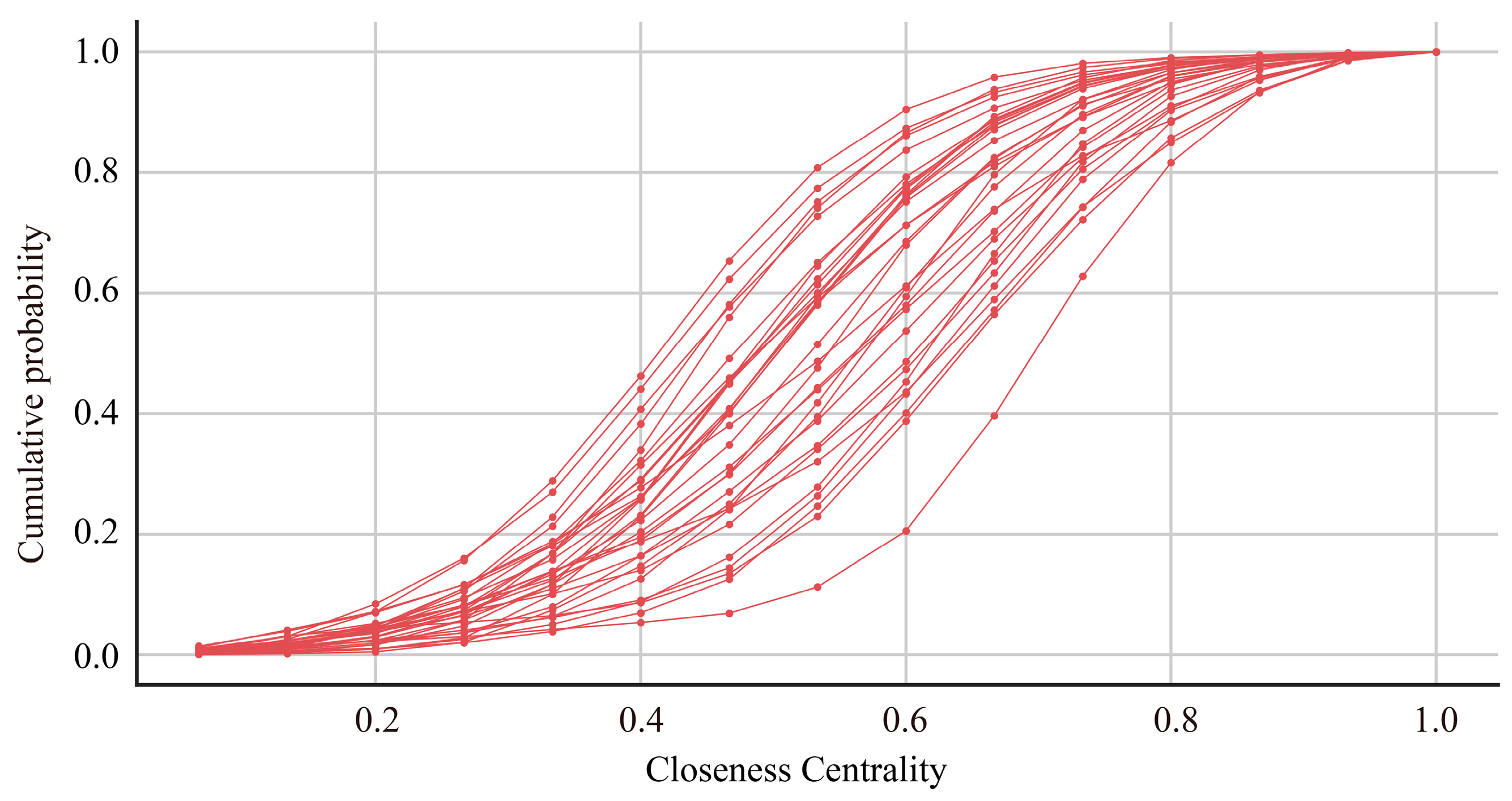

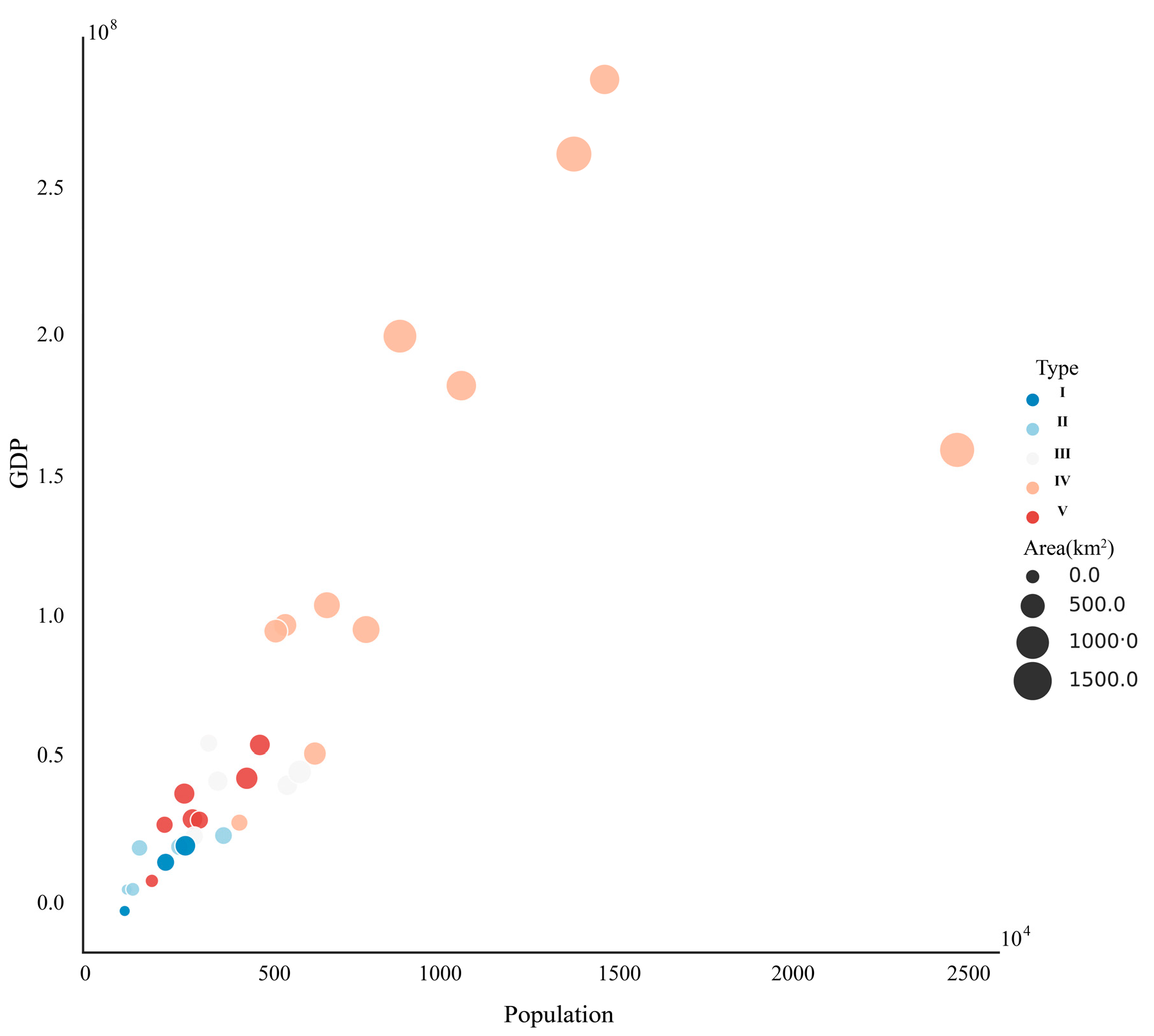

| Type | City List |
|---|---|
| I | UrumchiW, LhasaW, LanzhouW |
| II | YinchuanW, XiningW, NanningW, HohhotW, GuiyangW |
| III | ZhengzhouC, TaiyuanC, ShenyangN, HarbinN, ChangshaC |
| IV | ChongqingW, WuhanC, Xi’anW, TianjinE, ShijiazhuangE, ShanghaiE, NanjingE, HangzhouE, GuangzhouE, ChengduW, BeijingE |
| V | NanchangC, Kunmingw, Ji’nanE, HefeiC, HaikouE, FuzhouE, ChangchunN |
© 2019 by the authors. Licensee MDPI, Basel, Switzerland. This article is an open access article distributed under the terms and conditions of the Creative Commons Attribution (CC BY) license (http://creativecommons.org/licenses/by/4.0/).
Share and Cite
LOBsang, T.; Zhen, F.; Zhang, S. Can Urban Street Network Characteristics Indicate Economic Development Level? Evidence from Chinese Cities. ISPRS Int. J. Geo-Inf. 2020, 9, 3. https://doi.org/10.3390/ijgi9010003
LOBsang T, Zhen F, Zhang S. Can Urban Street Network Characteristics Indicate Economic Development Level? Evidence from Chinese Cities. ISPRS International Journal of Geo-Information. 2020; 9(1):3. https://doi.org/10.3390/ijgi9010003
Chicago/Turabian StyleLOBsang, Tashi, Feng Zhen, and Shanqi Zhang. 2020. "Can Urban Street Network Characteristics Indicate Economic Development Level? Evidence from Chinese Cities" ISPRS International Journal of Geo-Information 9, no. 1: 3. https://doi.org/10.3390/ijgi9010003
APA StyleLOBsang, T., Zhen, F., & Zhang, S. (2020). Can Urban Street Network Characteristics Indicate Economic Development Level? Evidence from Chinese Cities. ISPRS International Journal of Geo-Information, 9(1), 3. https://doi.org/10.3390/ijgi9010003





